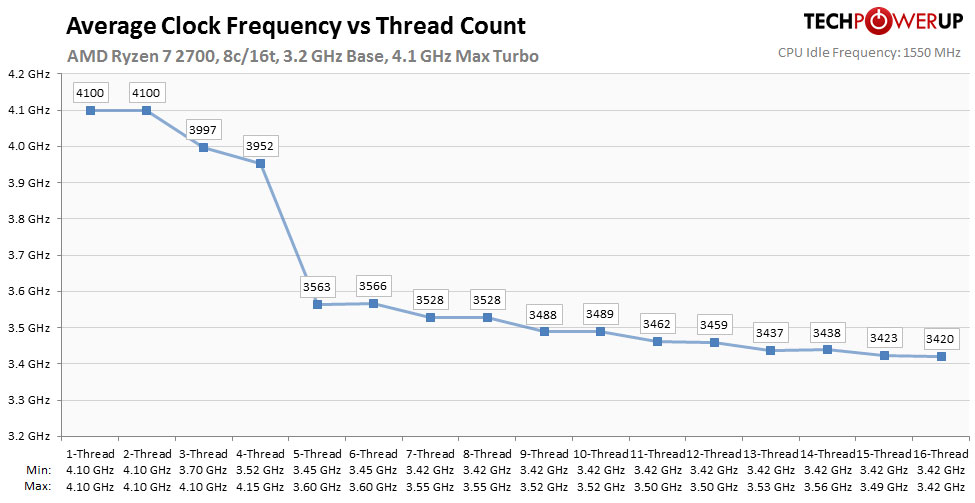 24
24
AMD Ryzen 7 2700 3.2 GHz Review
Power Consumption & Efficiency »Clock Frequencies and Boost Clock Analysis
Most modern processors feature a capability called "Boost" or "Turbo" that automatically overclocks the CPU beyond the nominal clock frequency provided certain conditions related to thread-count, power-draw, and temperatures are met. Our testing on this page investigates what actual real-life frequencies can be achieved in such scenarios. The data below presents the minimum, maximum, and average clock frequency of a given core/thread-count combination for a typical heavy workload. We start with one thread and go all the way up to the CPU's maximum thread count while at the same time measuring the average clock frequency for these timed testing runs.
Looking at the results, it becomes clear that the Ryzen 7 2700 will run near its highest boost clock with only two threads to then drop frequencies a little bit for three and four threads, after which a big drop reduces clocks to roughly 3.5 GHz, which sets the clock range for all additional thread count increases.
This got us curious, and we tested the Ryzen 7 2700's boost clock behavior for a comparison to its pricier sibling, the Ryzen 7 2700X, and the previous-generation flagship part, the Ryzen 7 1800X.

The data above springs up some interesting results. The top-dog Ryzen 7 2700X has a nearly linear reduction in boost clock speeds with an increase in threads, keeping up with AMD's claims of assured boost frequencies for each thread (which is the cornerstone of the multi-threaded performance uplift of Zen+).
The Ryzen 7 2700, on the other hand, also boosts clock speeds of all cores beyond the nominal clock of 3.20 GHz; however, its graph isn't as linear as the 2700X. There's a more pronounced drop in boost clocks beyond 4 threads, after which there's some semblance of linearity. Even with a 16-thread workload, you get some boost (of 200 MHz above nominal).
The previous-generation Ryzen 7 1800X works as expected. There's a linear drop in clock speed as you go from 1-thread to 4-thread, beyond which there's no boost clock, and parallelized workloads have to make do with nominal clocks of 3.70 GHz.
When not loaded at all, the processor's idle clock is 1550 MHz.
Jan 19th, 2025 01:19 EST
change timezone
Latest GPU Drivers
New Forum Posts
- DLSS Performance on 4K vs Native 1440p: Image Quality Comparison on 32-Inch Monitors (18)
- Advice please - AMD Radeon RX 5700 XT - PC Restarts (66)
- Will you buy a RTX 5090? (32)
- It is 2025, you have a PCI slot you really want to fill, what do you stick in it? (11)
- Crsystal Disk Info Confused? (1)
- Youtube buffers after 1mins on Windows 11 Pro/LTSC (39)
- Star Citizen (2508)
- New rtx 5070 (65)
- i have beeping issues in my geraphic card (1long beep and 3 short beep) (45)
- I bought SanDisk Extreme 500gb is it good for its price? (6)
Popular Reviews
- NVIDIA GeForce RTX 50 Technical Deep Dive
- ASRock Arc B570 Challenger OC Review
- Fosi Audio K7 Gaming Desktop DAC/Headphone Amplifier Review
- Sparkle B570 Guardian OC Review
- AMD Ryzen 7 9800X3D Review - The Best Gaming Processor
- Montech Heritage Pro Review - The Leather Case
- be quiet! Light Loop 360 mm AIO Review
- G-Wolves Hati-S2 8K Review
- Quick Look: Huion Kamvas 16 (Gen 3) Graphics Tablet
- ASUS ROG Strix B860-A Gaming Wi-Fi Review
Controversial News Posts
- NVIDIA 2025 International CES Keynote: Liveblog (468)
- AMD Debuts Radeon RX 9070 XT and RX 9070 Powered by RDNA 4, and FSR 4 (349)
- NVIDIA GeForce RTX 5090 Features 575 W TDP, RTX 5080 Carries 360 W TDP (217)
- AMD Radeon RX 9070 XT & RX 9070 Custom Models In Stock at European Stores (209)
- AMD Radeon RX 9070 XT Alleged Benchmark Leaks, Underwhelming Performance (204)
- Potential RTX 5090 and RTX 5080 Pricing in China Leaks (173)
- AMD Radeon RX 9070 XT Tested in Cyberpunk 2077 and Black Myth: Wukong (168)
- AMD Radeon RX 9070 XT Boosts up to 3.10 GHz, Board Power Can Reach up to 330W (167)